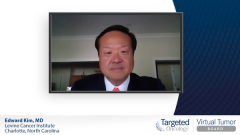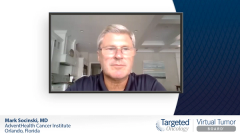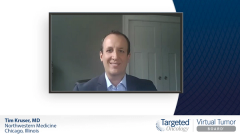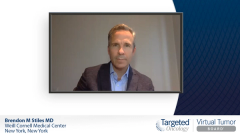
Case 3: Standard of Care in Unresectable Stage III NSCLC
Episodes in this series

Mark Socinski, MD: There’s probably little debate between Ed and me about this being the new standard of care. Tim, in the radiation oncology community, I assume this has been adopted as a standard of care.
Tim Kruser, MD: Yeah, absolutely. We’re all very heartened by the potential to see these people do well. We’ve always used 60 Gy of radiation in this setting, and we’ve been relatively underwhelmed by the outcome in that we get a lot of esophagitis and cause a lot of toxicity, and the vast majority of these people were developing metastatic disease. We’re all pretty enthusiastic to update this approach.
Mark Socinski, MD: We talked about the issue of starting it earlier. We had consensus that earlier is better to the extent that you can get it started within 2 weeks, so we favor doing this. What about the duration of therapy? Is it important to get a year of treatment? I’m asking that question because I did see some post hoc analysis suggesting that if you got close to the defined number of cycles, there seemed to be better outcomes. One has to wonder, is that the treatment or is that just more robust patients, they’re able to hang in there longer. It’s hard to know. Certainly, my practice has been that if this is the way they did it in the phase 3 trial that showed an advantage, that’s the way I’m going to do it in my practice once it becomes standard of care.
Ed, I want to ask you a couple of questions, because this comes up quite often. Does PD-L1 status impact your enthusiasm for this in the consolidation setting?
Edward Kim, MD: Yeah, you showed some of the data about PD-L1 status. We don’t measure it; we don’t use it. I know the Europeans feel a little different, and I guess I’ve never seen them approve on a post hoc analysis in another trial that went the other way. They would use a post hoc analysis to restrict utilization of some of this therapy in patients, but I didn’t feel it was right. You know, it is what it is, but in the United States, there should be no biomarker restriction based on the trial and its design.
Mark Socinski, MD: Yeah, let’s stick with that. What about driver biomarkers, like if you happen to know that the patient’s EGFR-mutation positive or ALK positive or RET positive or something like this? There were very few patients in the trial, so I don’t know how to make this decision in this particular setting.
Edward Kim, MD: This is clear, Ignorance is your friend. Until we have more mature data that we’re actually harming folks, it’s dangerous to make extrapolations. You use the pemetrexed example earlier. None of us would have thought that there would be any problem substituting in pemetrexed, but it just didn’t pan out. We’ve seen the same thing in head and neck. Right now I follow the trial the way it is. Once we think we have medicine figured out is when it gives us an opposite result, just like the radiation data earlier.
Mark Socinski, MD: Right. Tim, a lot of our efforts during the concurrent chemoradiotherapy part, treating esophagitis, dehydration, nutrition, all these sorts of things, there is a risk that certain patients will decline in their performance status. Of course, for PACIFIC, you had to be ECOG 0 to 1. Sometimes at the end of radiotherapy, that last week is pretty tough, and they might be like 1.8 and not exactly a 2, certainly not a 3. But do you extrapolate the PACIFIC data to those kinds of borderline performance status patients, or do you exclude them from it? What’s your thinking there?
Tim Kruser, MD: I try to fit my patients into that status. What I mean by that is, when you see that borderline patient, we know that the durvalumab has an overall survival benefit and we really want to strive to get that. The reason I bring that up is there will be times where someone is not doing super great at 35, 40 Gy, and I’m having a conversation with their medical oncologist. Boy, do we need that fifth or sixth cycle of concurrent carboplatin-Taxol. Can we drop those weeks that have a very uncertain benefit, so the patient is not a PS 2 at the end of this? They’re at 1 or 1.5, and we can get the durvalumab. That’s an important foresight to try to have with these patients with this new approach.
Transcript edited for clarity.










































